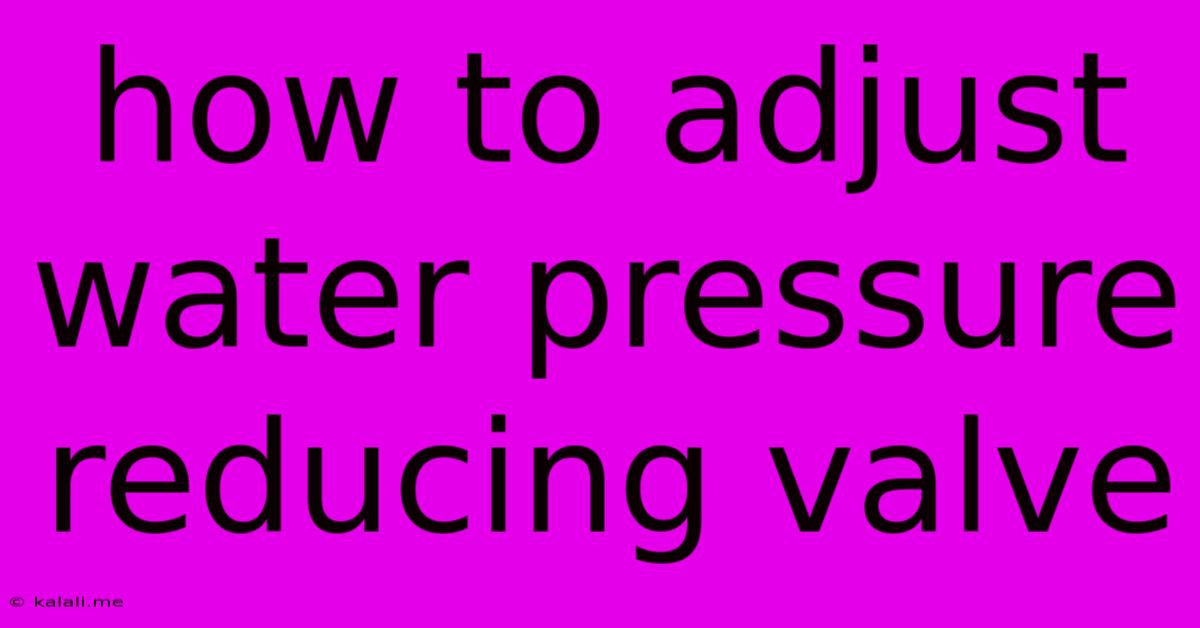How To Adjust Water Pressure Reducing Valve
Kalali
May 29, 2025 · 4 min read

Table of Contents
How to Adjust a Water Pressure Reducing Valve: A Step-by-Step Guide
Meta Description: Learn how to adjust your water pressure reducing valve to achieve the perfect water pressure in your home. This comprehensive guide provides step-by-step instructions and troubleshooting tips. Avoid costly plumbing repairs by mastering this simple DIY task.
Maintaining consistent and optimal water pressure is crucial for the smooth functioning of your household plumbing system. Too much pressure can lead to leaks, burst pipes, and premature wear on appliances, while too little pressure makes showering and using appliances frustrating. A water pressure reducing valve (WPRV) is designed to control this pressure, but sometimes it needs adjusting. This guide provides a clear, step-by-step approach to adjusting your water pressure reducing valve, empowering you to manage your home's water pressure effectively.
Understanding Your Water Pressure Reducing Valve
Before you begin, it’s essential to understand your WPRV's location and type. WPRVs are usually found on the main water supply line entering your home, often near the water meter. They come in various styles, but the adjustment method is generally similar. You'll typically find a dial, screw, or lever to adjust the pressure. Safety First! Always turn off the main water supply before working on the valve.
Tools You'll Need:
- Screwdriver (likely Phillips or flathead, depending on your valve): For adjusting the valve's pressure setting.
- Pressure Gauge: A crucial tool for accurately measuring your water pressure before and after adjustment. You can purchase one at most hardware stores.
- Plumbing Tape (Teflon Tape): To seal threads and prevent leaks.
- Wrench (adjustable or appropriate size): May be needed depending on the valve's design.
- Bucket or Towels: To catch any potential water spills.
Steps to Adjust Your Water Pressure Reducing Valve:
-
Locate the Valve: Find your water pressure reducing valve. It's usually a brass or metal fitting on the main water line.
-
Turn Off the Main Water Supply: This is critical to prevent water damage during the adjustment process. Locate your main water shut-off valve (usually near the water meter) and turn it completely off.
-
Check the Existing Pressure (Optional but Recommended): If you have a pressure gauge, connect it to a nearby faucet before adjusting the valve. This will give you a baseline reading of your current water pressure.
-
Locate the Adjustment Mechanism: Identify the adjustment mechanism on your WPRV. This is usually a screw, dial, or lever. Consult your valve's instruction manual if you're unsure.
-
Adjust the Valve Slowly: Carefully turn the adjustment mechanism. A small adjustment (1/4 to 1/2 turn) is usually sufficient. Turning the adjustment mechanism clockwise generally increases the pressure, while counter-clockwise decreases it.
-
Turn the Main Water Supply Back On: Once you've made an adjustment, carefully turn the main water supply back on.
-
Check the Water Pressure: Wait for a few minutes to allow the water pressure to stabilize, then check the pressure at a faucet using your pressure gauge. Ideal residential water pressure is typically between 40 and 60 PSI (pounds per square inch). Consult your local water company for recommended pressure levels in your area.
-
Repeat Steps 5-7 as Needed: Make further adjustments in small increments until you achieve the desired water pressure.
-
Inspect for Leaks: Carefully check all connections for any leaks. Tighten any fittings as needed.
-
Apply Teflon Tape (if needed): If you notice leaks, carefully remove the fitting, wrap Teflon tape around the threads, and reassemble.
Troubleshooting Common Issues:
-
Valve is Stuck: Try using penetrating oil on the adjustment mechanism to loosen it. If it remains stuck, you may need to replace the valve.
-
Pressure Remains Unchanged: The valve might be faulty. Consider contacting a qualified plumber for a replacement.
-
Pressure Fluctuates: There could be an issue with the main water supply line. Contact your local water utility company.
When to Call a Plumber:
If you're uncomfortable working with plumbing, or if you're unable to resolve the issue after following these steps, it's always best to call a qualified plumber. Improper adjustment could lead to further problems and costly repairs.
By following this guide, you can effectively adjust your water pressure reducing valve and maintain the optimal water pressure for your home. Remember to always prioritize safety and consult a professional if needed.
Latest Posts
Latest Posts
-
Channel 3 Open Failed Administratively Prohibited Open Failed
May 30, 2025
-
How To Make A Db With Non Static Data
May 30, 2025
-
Rules Of A Scratch In Pool
May 30, 2025
-
Are There Any Integers Between 0 And 1
May 30, 2025
-
How To Take Glue Off Glass
May 30, 2025
Related Post
Thank you for visiting our website which covers about How To Adjust Water Pressure Reducing Valve . We hope the information provided has been useful to you. Feel free to contact us if you have any questions or need further assistance. See you next time and don't miss to bookmark.